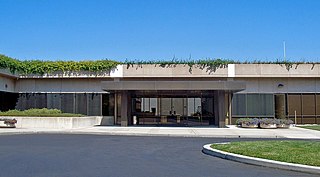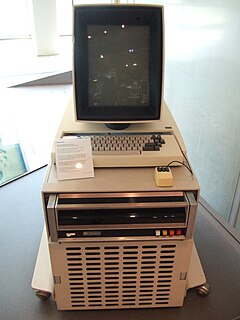
The graphical user interface is a form of user interface that allows users to interact with electronic devices through graphical icons and visual indicators such as secondary notation, instead of text-based user interfaces, typed command labels or text navigation. GUIs were introduced in reaction to the perceived steep learning curve of command-line interfaces (CLIs), which require commands to be typed on a computer keyboard.
Mesa is a programming language developed in the late 1970s at the Xerox Palo Alto Research Center in Palo Alto, California, United States. The language name was a pun based upon the programming language catchphrases of the time, because Mesa is a "high level" programming language.

PARC is a research and development company in Palo Alto, California, with a distinguished reputation for its contributions to information technology and hardware systems.

The Star workstation, officially named Xerox 8010 Information System, was the first commercial system to incorporate various technologies that have since become standard in personal computers, including a bitmapped display, a window-based graphical user interface, icons, folders, mouse (two-button), Ethernet networking, file servers, print servers, and e-mail.
Interlisp is a programming environment built around a version of the programming language Lisp. Interlisp development began in 1966 at Bolt, Beranek and Newman in Cambridge, Massachusetts with Lisp implemented for the Digital Equipment Corporation (DEC) PDP-1 computer by Danny Bobrow and D. L. Murphy. In 1970, BBN LISP was designed, which ran on PDP-10 machines running the operating system TENEX. In 1973, when Danny Bobrow, Warren Teitelman and Ronald Kaplan moved from BBN to the Xerox Palo Alto Research Center (PARC), it was renamed Interlisp. Interlisp became a popular Lisp development tool for artificial intelligence (AI) researchers at Stanford University and elsewhere in the community of the Defense Advanced Research Projects Agency (DARPA). Interlisp was notable for integrating interactive development tools into an integrated development environment (IDE), such as a debugger, an automatic correction tool for simple errors (via do what I mean software design, and analysis tools.

Xerox Daybreak is a workstation computer marketed by Xerox from 1985 to 1989.

Daniel Henry Holmes Ingalls Jr. is a pioneer of object-oriented computer programming and the principal architect, designer and implementer of five generations of Smalltalk environments. He designed the bytecoded virtual machine that made Smalltalk practical in 1976. He also invented bit blit, the general-purpose graphical operation that underlies most bitmap graphics systems today, and pop-up menus. He designed the generalizations of BitBlt to arbitrary color depth, with built-in scaling, rotation, and anti-aliasing. His major contributions to the Squeak system include the original concept of a Smalltalk written in itself and made portable and efficient by a Smalltalk-to-C translator.

Brampton Transit (BT) is a public transport bus operator for the City of Brampton in the Regional Municipality of Peel, and within the Greater Toronto Area (GTA) in Ontario, Canada. Brampton Transit began operations in 1974.
Empire is a 4X wargame created in 1972 by Peter Langston, taking its name from a Reed College board game of the same name. It was initially created by Langston in BASIC on an HP2000 minicomputer at Evergreen State College. When the host computer was retired, the source code to the game was lost. Subsequently, two other authors each independently wrote a new version of the game, both named Empire. In the decades since, numerous other versions of Empire have been developed for a wide variety of platforms.
Rational Rose XDE, an "eXtended Development Environment" for software developers, integrates with Microsoft Visual Studio .NET and Rational Application Developer. The Rational Software division of IBM, which previously produced Rational Rose, wrote this software.
Rational Software Architect is a modeling and development environment that uses the Unified Modeling Language (UML) for designing architecture for C++ and Java EE (JEE) applications and web services. Rational Software Architect is built on the Eclipse open-source software framework and includes capabilities focused on architectural code analysis, C++, and model-driven development (MDD) with the UML for creating applications and web services.

Rational Software Modeler (RSM), made by IBM's Rational Software division, is a Unified Modeling Language (UML) 2.0-based visual modeling and design tool. Rational Software Modeler is based on the Eclipse open-source software framework and is used for visual modeling and model-driven development (MDD) with UML for creating applications and web services. IBM ceased marketing Rational Software Modeler in 2010 and ended support for it in 2015. Much of the same functionality is now available through Rational Software Architect.

Fuji Xerox Towers, formerly known as IBM Towers, is a high-rise skyscraper located in the central business district of Singapore. It is located on 80 Anson Road, in the zone of Shenton Way and Tanjong Pagar. In fact, the building sits within four roads, namely Tanjong Pagar Road, Bernam Street, Keppel Road and Anson Road.

Haul trucks are off-highway, rigid dump trucks specifically engineered for use in high-production mining and heavy-duty construction environments.
A collaborative development environment (CDE) is an online meeting space where a software development project's stakeholders can work together, no matter what timezone or region they are in, to discuss, document, and produce project deliverables. The term was coined in 2002 by Grady Booch and Alan W. Brown.

The Federal Office of Civil Aviation is the Swiss civil aviation agency, a division of the Federal Department of Environment, Transport, Energy and Communications. Its head office is in Bern, and it has an office at Zurich Airport.
Sophie V. Vandebroek is a Belgian electrical engineer and business executive, who was the Chief Technology Officer of Xerox, and President of Xerox Innovation Group until December 2016. Vandebroek has been CTO and a corporate vice president of Xerox corporation since 2006.











